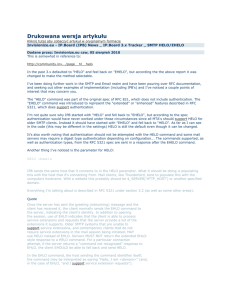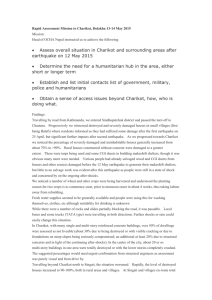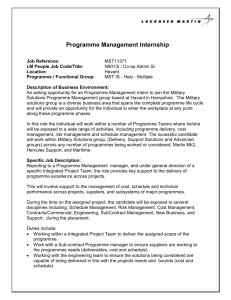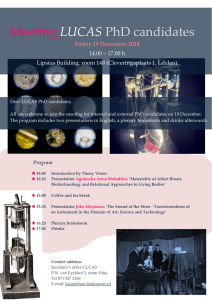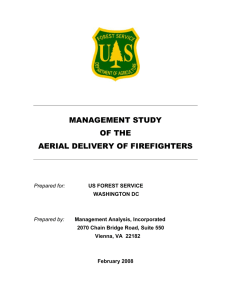December 1981, #50 - China Lake Mountain Rescue Group
advertisement
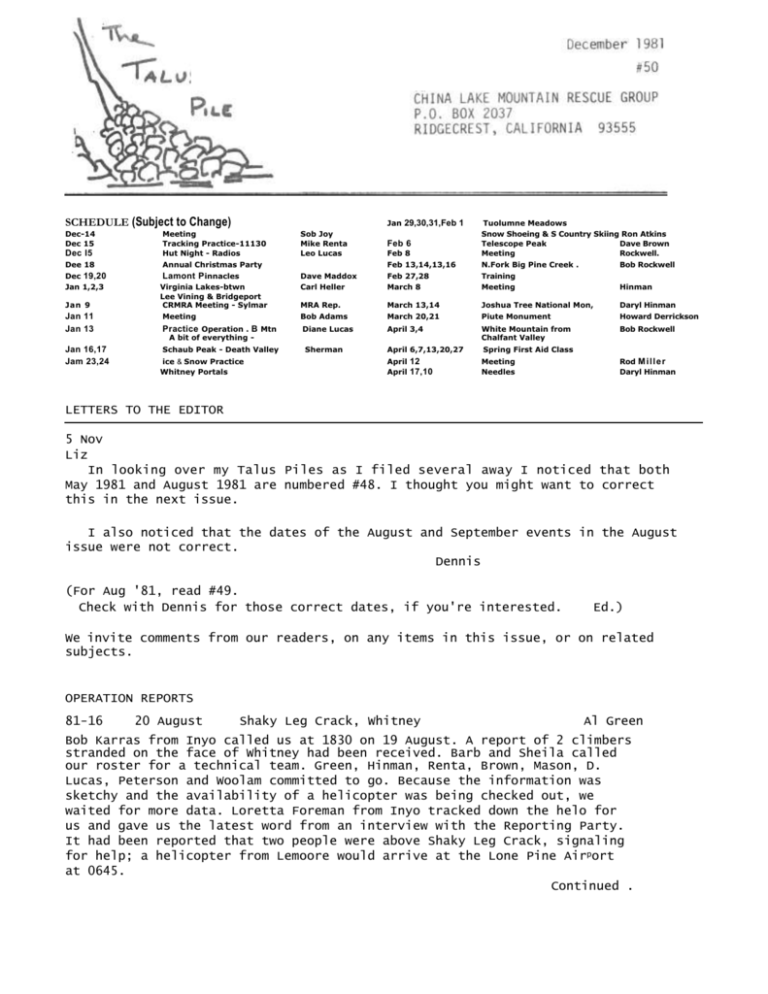
SCHEDULE (Subject to Change) Dec-14 Dec 15 Dec I5 Dee 18 Dec 19,20 Jan 1,2,3 Jan 9 Jan 29,30,31,Feb 1 Meeting Tracking Practice-11130 Hut Night - Radios Annual Christmas Party Lamont P innacles Virginia Lakes-btwn Lee Vining & Bridgeport CRMRA Meeting - Sylmar Sob Joy Mike Renta Leo Lucas Feb 6 Feb 8 Feb 13,14,13,16 Tuolumne Meadows Snow Shoeing & S Country Skiing Ron Atkins Telescope Peak Dave Brown Meeting Rockwell. N.Fork Big Pine Creek . Bob Rockwell Dave Maddox Carl Heller Feb 27,28 March 8 Training Meeting Hinman MRA Rep. March 13,14 Joshua Tree National Mon, Daryl Hinman Jan 11 Jan 13 Meeting Bob Adams March 20,21 Piute Monument Howard Derrickson Practice Operation . B Mtn Diane Lucas April 3,4 White Mountain from Chalfant Valley Bob Rockwell Jan 16,17 Jam 23,24 Schaub Peak - Death Valley A bit of everything - ice & Snow Practice Whitney Portals Sherman April 6,7,13,20,27 Spring First Aid Class April 12 April 17,10 Meeting Needles Rod M i l l er Daryl Hinman LETTERS TO THE EDITOR 5 Nov Liz In looking over my Talus Piles as I filed several away I noticed that both May 1981 and August 1981 are numbered #48. I thought you might want to correct this in the next issue. I also noticed that the dates of the August and September events in the August issue were not correct. Dennis (For Aug '81, read #49. Check with Dennis for those correct dates, if you're interested. Ed.) We invite comments from our readers, on any items in this issue, or on related subjects. OPERATION REPORTS 81-16 20 August Shaky Leg Crack, Whitney Al Green Bob Karras from Inyo called us at 1830 on 19 August. A report of 2 climbers stranded on the face of Whitney had been received. Barb and Sheila called our roster for a technical team. Green, Hinman, Renta, Brown, Mason, D. Lucas, Peterson and Woolam committed to go. Because the information was sketchy and the availability of a helicopter was being checked out, we waited for more data. Loretta Foreman from Inyo tracked down the helo for us and gave us the latest word from an interview with the Reporting Party. It had been reported that two people were above Shaky Leg Crack, signaling for help; a helicopter from Lemoore would arrive at the Lone Pine Airport at 0645. Continued . Page 2 Dec 1981 continuing, Whitney We left China Lake at 0515, arriving at Lone Pine at 0630. The Lemoore chopper with LCDR Dan Ellison, Lt Kurt Rierkan, AE1 Dave Bockman, AT2 Reg Barnes and HN Tom Barry arrived at 0700. They picked up Daryl Hinman and left at 0730 to search the face. They found the victims at East Face Lake and were back at Lone Pine by 0835. The climbers had not gotten above Shaky Leg. In fact, it was Stephen's attempt to lead Shaky Leg that had resulted in the problem. Stephen Kille and Mike Wigney from England were turned back by Stephen's 30-foot fall. Stephen sustained a head injury and numerous cuts and bruises. They managed to get down to East Face Lake by themselves. It took them from about 1830 to 2230 - normally about 30 minutes would be a leisurely pace. Their retreat to East Face Lake made the rescue much easier. 81-17 26-28 August Dragon Peak Search and Recovery Dennis Burge Bruce Dyer, 24, of Orange, CA, had gone alone on a backpacking trip the weekend of 15 August. His plan had been to drive to Onion Valley, to camp at Golden Trout Lake for hiking, and to return home Sunday night. When Bruce did not report for work on Monday, his roommate, Dave Bezzone, was called. Dave drove to Onion Valley and located Bruce's car. On Tuesday he hiked up to the small lake below Golden Trout Lake, but found no trace. He then hiked out to get in touch with the Inyo Sheriff's office. The Inyo Posse sent in a team of 4 that night. Wednesday morning they found Bruce's backpack on the south side of the lake east of Dragon Peak (next canyon north from Golden Trout). At 0820, Wednesday, August 26, I received a call from Loretta Foreman of the Inyo County Sheriff's Posse. She requested that CLMRG get a team on standby for a search in the Golden Trout Lake area, with the probability of a call-out when they heard from their team on the scene. I asked Sheila Rockwell to get a team. We determined that the NWC helo would be unavailable for a search that day. Sheila informed me we had a team of 6; I called Loretta saying that 7 of us would drive to Independence. This number (7) shrank to 4 by departure time. At 1215 Wednesday, our team (Harris, Willer, Peterson, and I) met the Inyo and June Lake teams at the Independence airport. The Forest Service contract helo would be available for transporting searchers, but first intended to do an aerial search of the area. When this produced no results, the helo began ferrying (at 1530) 9 searchers to the lake where the pack had been found. An advance base was set up with John Ellsworth of June Lake as team leader; Pat Elliott of Inyo SAR and I remained at base camp to coordinate the effort. The searchers checked the pass to the south of Dragon Peak as well as the top of the ridge leading to North Dragon Pass; they found no trace of Bruce. When we learned that the NWC helo would be coming on Thursday, I called for more Continued . . Page 3 Dec 81 Continuing Dragon Peak searchers to come with the helo. Meanwhile, the team on the spot hiked from Onion Valley to the advance base, to be ready to search in the early a.m. The NWC helo arrived about 0730 bringing more CLMRG members (Green, Adams, D.Lucas, Woodworth). The pilot was LCOL Scott Smith, USMC. With the helo were Ltjg Brent Norman, copilot, AD3 Larry Clark& AT3 Rick Jones, crewmen, and HM3 Stephanie Moore, corpsman. Al and Dianne were flown in to advance base. They intended to climb Dragon Peak, since this area had not been checked over. Meanwhile the helo ferried other groups of 2 and 3 to check west of Dragon. At 1300 Al and Dianne neared the south (lower) summit, carefully checking off to both sides as they went. Down the steep dropoff to the east, Al saw what might be a body, perhaps 1000 feet below. It was confirmed to be Bruce's body. The combination of an afternoon thundershower and the Forest Service recalling the contract helo to a fire prevented the evacuation of the body that day. Most of the searchers hiked out to Onion Valley in the rain. COMMENTS 1. The hazards of solo climbing on a Class 3 peak are obvious. Bruce was not known to be a climber; apparently he found himself with extra time and made the decision to climb. 2. This was a complex operation with 10 agencies or teams involving more than 50 people. This complexity caused communication and management problems, since other teams' capabilities were mutually unknown. But everything worked out. 3. Do not count on the Forest Service contract helo during the height of the fire season. 4, Team members should bring rain gear, bivvy gear, and hard hats for an operation like this one. Hard hats in particular when around the Forest Service helo. 81-18 12 September Darwin Mobilization Al Green At 2045, a call came from Dan Lucas, Inyo County. Apparent heart attack or heat stroke victim, in vicinity of Zinc Hill. Five CLMRG people were ready to go at 2130. China Lake helo pilot Lt Denny Wilcox decided to go in. The helo picked up the victim. We turned off our fire drill, bowing to modern technology. 81-19 19 September Alert Al Jones A reported injured person near North Lake. Reporting person heard calls for help, but could not locate source. At 1515 Bob Karrass, Inyo County,requested we standby. Alert was cancelled 3 hours later (1815). Inyo felt there was insufficient information to justify initiating an operation. Seven team members were ready to go. Page 4 Dec 81 81-20 15 October Glacier Lodge/Coyote Flat Search Daryl Hinman At 0400 Thursday morning, Dan Lucas of the Inyo County Sheriff's Department called Sheila Rockwell, requesting China Lake Mountain Rescue Group (CLMRG) to initiate a search for two missing hunters in the Coyote Flat area. Lucas had requested a helo through Scott AFB and an NWC helo was preparing to fly. Initially I requested a callout of only Winter-qualified personnel; since only three (including myself) of the possible fifteen were willing and able to respond the entire roster was eventually called. A total of 7 field members responded (Burge, Adams, Vernon, Huey, Gleason, Derrickson, Hinman). Sires operated the radios at base camp, and Fletcher monitored the radio in Ridgecrest. The two missing hunters, Mike Sprat, 36 and Cliff Arbuckle, 15, were from Big Pine. Mike's brother had driven the pair to Coyote Flat 94-wheel drive by way of Bishop) and had let them off near the cattlemen's cabin early on the previous day. At that time, it was snowing. They planned to hunt during the morning and at noon meet the brother back at the cabin. If the hunters and the brother did not meet at the cabin, the hunters planned to walk out to Glacier Lodge (a 5-mile downhill trail). After the pair of hunters failed to make either meeting, the Inyo Sheriff was notified. Deputies drove to Coyote Flat that evening in hope that the hunters would be at the cabin; there was a foot of fresh snow. An organized search was initiated for the following day. Arriving at the CLMRG hut, I learned (through the Officer of the Day) that helo transportation for CLMRG personnel would be unavailable for the operation. So, we left for Big Pine by automobile. As we traveled up the Owens Valley we could see the clearing skies, but evidence that the previous day's storm had dropped plenty of fresh snow. We arrived at base camp in Big Pine, where over 30 local people had gathered. This group included family and friends of the victims, and several people on horseback who were willing to search the area. Unfortunately (from an organizational point of view), Dan Lucas the Sheriff's Office coordinator for the operation, was not at base camp. The NWC helo was flying an air search, with the victim's brother and Deputy Lucas on board. I interviewed the victim's father, who revealed that the pair had adequate clothing (this proved to be false), but no extra clothes, and only a small amount of food in a day pack. He said they were both in good physical condition (this also proved to be untrue). Mike was said to be familiar with the area and well experienced in wilderness travel. The horsemen were local ranchers who run cattle in the area to be searched; they were loosely organized with a couple of leaders. Although they had no experience in search techniques, their extensive knowledge of the area was obviously a useful asset. Considering the resources available, it seemed appropriate to send the horsemen up the 2 trails that begin near Glacier Lodge and later join in Logger Flat. CLMRG personnel could be flown into Coyote Flat where a search of the immediate area could be followed by a search down the trail toward Logger Flat, meeting the horsemen at some point. Meanwhile the helo could continue searching from the air. These were my plans which I thought to discuss with Dan Lucas shortly. As we waited, expecting the helo to return from the initial air search at any time, the family and friends of the victims (in particular the boy's father) were becoming increasingly concerned at the lack of action. Since the helo was not using the MRA frequency we were out of communication with Lucas. At the insistence of the boy's father (as much as anything) I asked the horsemen if they would drive up to Glacier Lodge and start up the previously mentioned trails, even though I had no authority over the search. Although they were reluctant to go before the Sheriff returned, they finally agreed, taking one of our radios (which proved useful). Continued . . Page 5 Dec 81 Continuing Coyote Flat . . Sires decided to use the Inyo frequency on the radio in the Sheriff's car. He was able to contact the helo, and was told that we should stay put because they were not ready to commit to a ground search and that he (Sires) should make no further transmissions to the helo. After hearing that message, I sent Burge and Gleason with the PT-400 up to Glacier Lodge, to have the horsemen wait at the roadhead. Later a deputy, who had been waiting at the end of the road, arrived and relieved me of the pressure from the victim's family. Then, Sires received a radio message that the boy had been found. At the same time, the helo was coming in for a landing after almost three hours of air search. Although I had assumed the transmission had come from the helo, the helo landed without the boy, and Lucas knew nothing of the boy's reappearance. I ran to Sires' car to confirm what he had heard. Talking to Burge at Glacier Lodge, I learned that the boy had walked out unassisted, but without Mike. Cliff was in good condition for having spent a night out in a foot of new snow, and no shelter but the clothes he was wearing. We postponed questions until he was brought down to Big Pine. Cliff said that he and Mike had been walking down the previous night when Mike began to complain that his legs were "tight." They stopped to spend the night; when Cliff woke in the morning Mike was gone. Cliff looked around, and called for him, but continued his walk out when there was no response. Cliff's description of the area where he had slept sounded like the area near Logger Flat, which is only about a mile from Glacier Lodge. We sent in two ground teams, one to backtrack Cliff and the other along the direct trail to Logger Flat. The horsemen had started earlier. As we started up the trail, the helo (with Lucas still on board) aided by the boy's location description, spotted a person lying in the snow. The horsemen were directed by radio to that location, and a smoke grenade and body bag dropped. After "confirmation" that the person was deceased, the helo departed with some rather insensitive instructions to the untrained horsemen. Continuing up the trail, we met the returning horsemen with the body. As we all descended to the road head, we kept getting these unusual radio transmission: "the hospital wants to know if there were any external injuries", "the hospital wants you to hurry", and "do you have a hypothermia thermometer?" Apparently "the hospital" thought that the victim could possibly be alive. We had already quizzed the horse men as to the state of the victim. They repeated their observations and willingly admitted they had no training in such matters. Three of us (CLMRG) checked the victim's condition, but could perceive no pulse at the carotid artery. The skin and tissue felt normal, other than being very cold. We went on to the road. Later I talked to Doctor Dillon at the Northern Inyo Hospital in Bishop, who had been the one concerned for the victim. He has a particular interest in hypothermia and spent five hours trying to rewarm and revive the victim (although unsuccessful). CLMRG was home by early evening. COMMENTS: I. The helo has become one we have become dependent on be unavailable. CLMRG teams had not tried to coordinate of the dominant tools for mountain rescue. Consequently its use. For a number of reasons the helo's services may could have been in the field 4 hours sooner, if I our efforts with the helo's. Continued . . Page 6 Dec 81 Continuing Coyote Flats, Comments . . 2. The lack of a recognized official in base camp had a detrimental effect, both for organization and for authority. Because the victims were local people, a large group of bystanders was present. Having to spend an overly large amount of time in delicate relations with base camp visitors detracts from our chief mission. 3. I should have had the radio vehicle (Sire's car, in this case) parked in an isolated area of base camp. Bystanders heard much of what was being said on the radio. CLMRG members and helo personnel should remember that sensitive and apprehensive ears may be listening to our remarks on the radio. 4. Inyo frequency radios should always be taken on operations in Inyo County. Extra radios will help with problems of radio shortage and/or failure. 5. Searching from the air is valuable because a large area can be covered quickly; unfortunately it is not possible to search with much detail from the air. It was a mistake to totally rely on the air search. Valuable resources sat idle at base camp while the helo spent over 3 hours on an initial run. Cliff said the helo had flown directly over him, without his being spotted. If the horsemen had started in earlier, they probably would have met Cliff, since they went up the same drainage he came out. 6. I should have sent a radio team to the Glacier Lodge roadhead sooner. This would have established communications with that area and also served to relieve some of the anxiety of the victims' families. 7. Mike Sprat was wearing a tee-shirt, cotton hooded sweatshirt, levis and thermal boots. This clothing provided little protection under the cold, wet conditions. Later the next day, Cliff said that Mike had collapsed that night as they were coming through Logger Flat. Cliff (who weighs 110 pounds) attempted to drag him to shelter. Failing, he went to sleep under a nearby tree. Cliff, who was likely confused from hypothermia, forgot what had happened to Mike until much later. The horsemen stated that it appeared that Mike had been dragged a ways, and had not moved again. 8. In Scandinavian countries, a person is not considered dead until he is both warm and dead. Dr. Dillon, in Bishop, was disturbed that the hypothermia victim had not been brought out by helo for immediate treatment. We should remember this doctor for future hypothermia cases; most doctors would not attempt rewarming and reviving of someone in that state. We should also have hypothermia thermometers to the Group first aid kits, and learn how to use them. BACKPACKER'S PALSY Modem Medicine magazine reports that backpackers who try to carry too much weight too frequently may develop a condition dubbed "backpacker's palsy." The nerves in backpackers' shoulders are compressed by the loads they carry to the point that_ they experience numbness, weakness and atrophy of the arms and shoulders. One patient who carried half his body weight for 3 years did not improve during the year he stopped backpacking and may suffer weakness for years to come. Other backpackers with less severe cases may find improvement after several months of no backpacking, heavy lifting or strenuous exercise. FALL 1951 • FAMILY SAFETY 31 Page 7 Dec 81 81-21 Search Tuolumne County Lee Lucas CLMRG sent 6 searchers to an MRA operation, for a lost hunter. Detailed report in the next newsletter. 81-22 Transit Riverside 31 October Don Harris A 21/2-year-old boy was reported missing in the Lake Skinner area near Rancho California. At 0905 Al Andrews of RMRU requested a search team. At 1015 a 4-man team left China Lake (Peterson, Dan Sherman, Rod Willer, and Harris). Arrived at Riverside at 1305. Called base camp to learn that boy had been found 30 minutes earlier. A POLISH RAPPELER?
